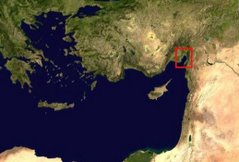Welcome to Real-Time Archaeology!
Our names are Amanda Iacobelli, Jeff Rop, and Ben Bradshaw. We are all graduate students studying ancient history and/or archaeology at the Pennsylvania State University. From June 22-July 20 of 2007, we will be participating in an archaeological field survey under the direction of Dr. Ann Killebrew. The survey will take place in part of the Cilician Plain in southeastern Turkey.
This blog is an attempt to document our experiences before, during, and after the archaeological survey. While in the field we intend to update the blog at least every other day with pictures, comments on daily life in the field, and short topical essays on relevant subjects such as field techniques and the potential historical significance of our finds. Until then, we will be posting historical summaries of the cultures that populated and crossed paths in this area, as well as practical information regarding the preparatory steps involved in organizing and participating in an archaeological expedition. Once the field work is done, we expect to maintain the blog, posting with an eye toward the 2008 field season.
Our intention here is to cater to a wide audience, including the general public, archaeology students, and professional scholars. We will be blogging both from academic and personal perspectives, so that our readers will have a sense of what life is like on an archaeological field survey, what techniques are used to map out a previously unsurveyed region (with the objective of eventually choosing a specific site to excavate), and how interested students and non-professionals can themselves participate in archaeological field work. We also hope that this site will serve as a sort of real-time repository of information as the archaeological project progresses (hence the title of the blog), giving scholars bits of pre-publication data and illustrating for the general public how that data is collected, compiled, and eventually (if all goes well) published.
The nature of the survey team and the area to be studied lends itself particularly well to a blog project such as ours. First, the team includes both New (represented primarily by Dr. Ken Hirth) and Old World (Dr. Killebrew) archeologists. They will be working together, integrating two similar but distinctive approaches to data collection and analysis. The methods utilized will range from simple field-walking techniques and landscape survey to Global Positioning Satellite and Geographical Information Systems technologies.
Second, the specific area being studied has not been previously explored by archaeologists yet is burgeoning with historical significance. The Cilician plain has truly been a crossroads for ancient civilizations of the east and west from the Neolithic period, particularly at neighboring Tarsus and Mersin (circa 7800 years Before Present), onward. The area has witnessed and harbored important nations and events. To name a few: Cilicia may have been home to the mysterious Sea Peoples (conceivably proto-Philistines) at the close of the Bronze Age; a battleground for armies of Alexander the Great and the Persian King Darius III; and a settlement for the infamous Cilician pirates, who threatened Roman trade in the Mediterranean and were defeated by Pompeius Magnus (see future posts for further illumination on these, and other, historical topics). A preliminary survey in our target locus has already, in fact, presented a promising array of data on a number of cultures dating from the Bronze Age to the Ottoman period.
This blog, then, is an attempt to shed light on the full history of an archaeological project from its inception to its conclusion (bearing in mind that the work will never, truly, be concluded). We will record, in the public eye, the process of planning a project, undertaking a field survey, site selection and excavation, and ultimately the publication of its findings. At the risk of sounding rather presumptuous, we envision our work here as a unique way of contributing to the long-established effort to make scholarly research more accessible and more immediate to the general public.
Stay tuned.
-Jeff, Amanda, and Ben
Sunday, February 25, 2007
Subscribe to:
Posts (Atom)

